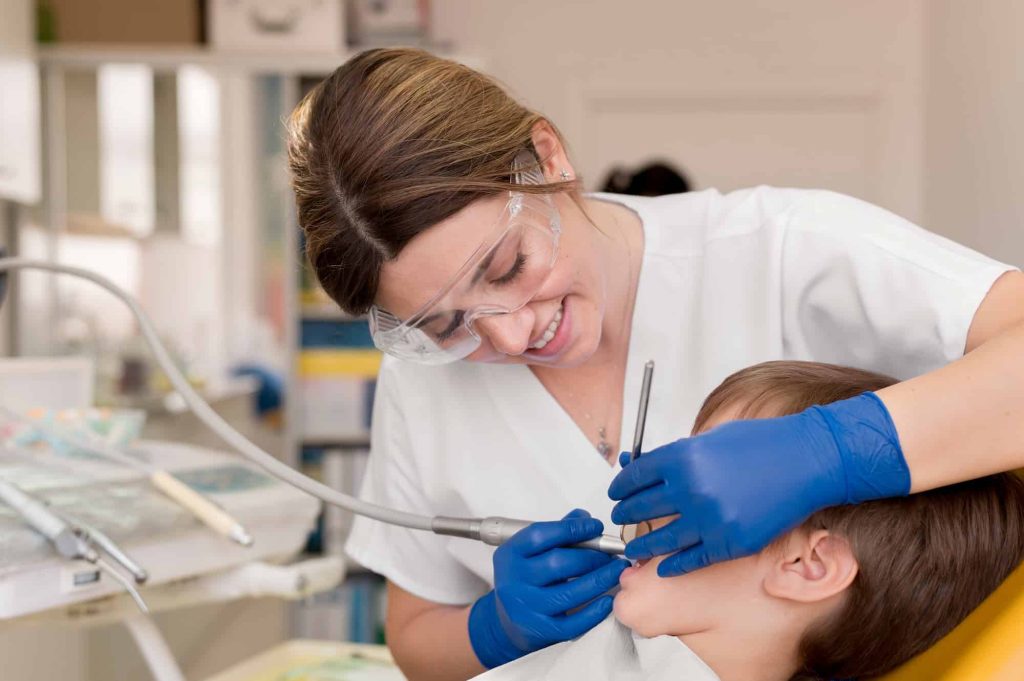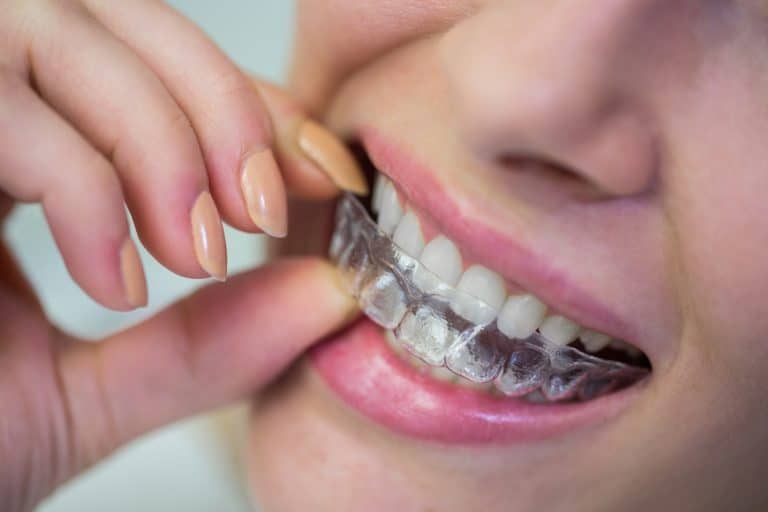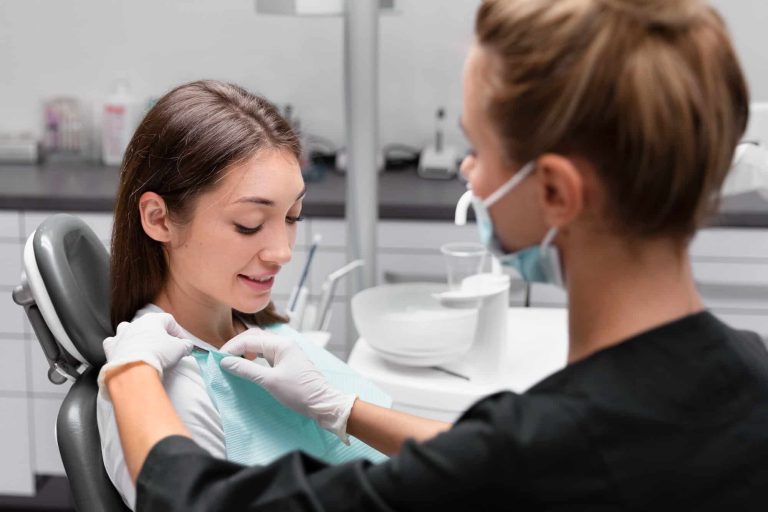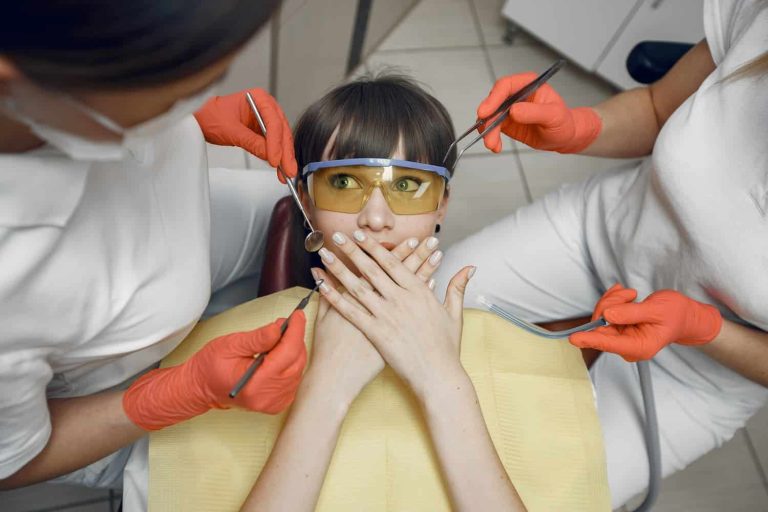Table of Contents

Accidentally cracking, chipping, or breaking a tooth can catch you off guard, but don’t stress—it happens more often than you might think. Whether you’ve bitten down on something too hard, taken a tumble, or had a random mishap, knowing what to do next can make all the difference in saving your smile.
In this post, we’ll walk you through the most common reasons teeth get damaged, the do’s and don’ts for handling a dental emergency, and how your dentist can quickly and effectively repair the damage. By the end, you’ll feel confident, knowing exactly what steps to take if it happens to you or someone close to you.
Common Causes of Tooth Chips, Cracks, and Breaks
Biting Down on Hard Foods
We’ve all been there—you’re enjoying a snack, and suddenly, you bite into something unexpectedly hard. Whether it’s ice, a rogue popcorn kernel, or a hard lolly, it only takes a second for your tooth to chip or crack. Even a hard knock on a glass or metal water bottle can cause issues. While teeth are incredibly strong, they’re not invincible. Hard foods can put too much pressure on your enamel, causing small chips or cracks that may not be noticeable right away but can become a bigger problem later.
Trauma or Injury
Life happens, and so do accidents. Whether it’s falling off a bike, taking a hit during sports, or any unexpected blow to the face, trauma can quickly lead to a cracked or broken tooth. Athletes, especially those in contact sports, are at higher risk of tooth injuries if they aren’t wearing a mouthguard. The incisors are usually affected due to being at the front of the mouth. Children are especially at risk as they are more active and can easily fall while playing or running around. A simple fall can lead to a dental emergency, so it’s important to be cautious and protect your smile whenever possible.
Weakened Teeth from Decay
Teeth that are weakened by decay or untreated cavities are more vulnerable to damage. If decay goes unchecked, it erodes the tooth’s structure, making it easier for it to chip or break—even from something as simple as chewing. Regular dental check-ups are essential for catching decay early and preventing the need for more extensive repairs later on.
Teeth Grinding (Bruxism)
If you’re someone who grinds their teeth, especially at night, you may be causing more harm than you realise. Over time, grinding can wear down your tooth enamel, the protective outer layer of your teeth, making them more prone to cracks and chips. You may not even notice you’re doing it, but waking up with a sore jaw or tooth sensitivity can be a sign. Wearing a night guard can help protect your teeth while you sleep.
Large Fillings or Previous Dental Work
Teeth with large fillings or that have undergone significant dental work can be more fragile. While the treatment restores the tooth, the natural structure is often reduced, making the tooth more susceptible to breakage under pressure. Biting down on hard objects or just everyday wear and tear can take its toll on these teeth, making them more likely to chip or crack.
What Do Cracked, Chipped, and Broken Teeth Look and Feel Like?
Recognising the signs of a damaged tooth can be really helpful, especially if you’re feeling mild discomfort. Let’s break down how to identify whether your tooth might be cracked, chipped, or broken:
Cracked Teeth
What They Look Like:
Cracks can be tricky to spot, particularly if they’re small. You might see faint lines, sometimes called “craze lines,” across the tooth or a vertical crack that could extend below the gumline. They might not be obvious right away, so keep an eye out!
What They Feel Like:
If you have a cracked tooth, you might notice some pain when chewing—especially when you bite down or release pressure. Hot or cold foods can also trigger that sharp sensitivity. Sometimes, the pain isn’t immediate, so it’s best not to ignore it, as cracks can worsen over time if left untreated.
Chipped Teeth
What They Look Like:
Chipped teeth usually have a jagged or uneven edge where a small piece of enamel has broken off. These chips are often visible, especially on front teeth, which can make them more noticeable when you smile.
What They Feel Like:
A chipped tooth might not hurt right away unless the chip is close to the nerve. You could feel a sharp edge with your tongue, which might irritate your lips or cheeks, making it a bit uncomfortable.
Broken Teeth
What They Look Like:
When a tooth is broken, it’s typically more dramatic than just a chip. You may notice a larger portion of the tooth missing, and the break could expose the inner layers, which may look darker or feel more sensitive compared to the other teeth.
What They Feel Like:
Broken teeth often come with more intense pain, especially if the break has exposed the tooth’s nerve. You might feel significant sensitivity to temperature, and chewing could be quite painful. In some cases, you might even notice bleeding or that the broken area feels loose.
Key Differences in How They Feel
- Cracks often lead to discomfort when chewing or when your tooth is exposed to extreme temperatures.
- Chips can feel rough but usually don’t hurt unless they’re deep or close to the nerve.
- Breaks tend to be more painful, causing sharp sensitivity and discomfort—and they may even bleed.
Do’s and Don’ts After a Tooth Chips, Cracks or Breaks
When your tooth gets damaged, acting quickly and wisely can make all the difference in keeping your smile healthy. Here’s a handy guide on what you should and shouldn’t do to help protect your tooth:
Do’s:
Rinse Your Mouth with Warm Water
First things first! Cleaning the area is essential to remove any debris and help prevent infection. Rinsing with warm water is gentle and soothing, making it a great way to start. If you have salt on hand, you can mix a little in for an extra cleansing boost.
Apply a Cold Compress
If you’re experiencing swelling or pain, holding a cold compress against your cheek near the affected area can be a game changer. This can help reduce swelling and provide some relief from discomfort. Just remember to wrap the compress in a cloth to protect your skin!
Save Any Tooth Fragments
- When you find the broken piece, be gentle! Avoid touching the fragment too much, as this can introduce bacteria or cause further damage. Pick it up by the edges rather than the broken surfaces to minimise handling.
- If the tooth fragment is dirty, gently rinse it under cool running water. Be careful not to scrub hard, as it can harm the delicate structure of the tooth.
- Place it in a clean container with milk or a saline solution (like the one used for contact lenses). The calcium in milk helps preserve the tooth’s structure, while saline keeps it moist. If you don’t have either on hand, clean water is the next best option.
- Store the fragment in a clean, sealed container. This could be a small plastic or glass container with a lid. Avoid using tissues or cloths, as they can stick to the tooth and make it difficult for your dentist to handle.
- It’s crucial to keep the fragment moist during transport. Don’t let it dry out, as this can decrease the chances of successful reattachment. Ensure that there’s enough liquid in the container to cover the fragment without submerging it completely.
- Time is of the essence! Try to see your dentist as soon as possible—ideally within 30 minutes to an hour after the incident. The sooner you can get the tooth fragment to your dentist, the better the chances of a successful reattachment. Call ahead to let them know you’re coming, so they can prepare for your visit.

See a Dentist Quickly
Don’t delay in getting professional help! Even if you’re not in pain, it’s crucial to see a dentist as soon as you can. The longer you wait, the higher the risk of infection or further damage. Remember, your dentist is there to help, and addressing the issue early can save you from more extensive treatments later on.
Don’ts:
Don’t Ignore the Problem
Even a small chip or crack can lead to bigger issues if left untreated, like infection or tooth loss. It’s easy to brush it off, but it’s always best to have a dentist assess the damage. Think of it like a small warning sign—address it before it turns into a bigger headache!
Don’t Use Your Tongue or Fingers to Explore the Area
We know it’s tempting to poke around with your tongue or fingers, but this can introduce bacteria to the area or worsen the condition. Instead, try to resist the urge and keep the area as clean and undisturbed as possible.
Avoid Eating Hard or Sticky Foods
Until you can see your dentist, it’s wise to avoid putting pressure on the damaged tooth. Eating hard or sticky foods can aggravate the problem and cause more pain. Stick to soft foods and be gentle while chewing to protect your tooth from further harm.
What Your Dentist Will Do
Once you’re in the dentist’s chair, the type of treatment you’ll need depends on how badly your tooth is damaged. A minor chip may not require any treatment, whereas a badly damaged tooth may need an x-ray to assess the extent of tooth and/or nerve damage. The following are some of the most common treatments for tooth repairs:
Dental Bonding
For minor chips, dental bonding is often the easiest and quickest fix. Your dentist will use a tooth-coloured resin to fill in the damaged area, carefully shaping and smoothing it to blend seamlessly with the rest of your tooth. Once the bonding material is hardened with a special light, your tooth will be restored to its natural shape and function. It’s a great option for small repairs, and the results look natural—most people won’t even notice you had any work done!
Dental Crown
If your tooth has a large crack or a significant piece has broken off, a dental crown may be the best solution. A crown is like a custom-made cap that fits over your tooth, protecting and strengthening it. Your dentist will shape the remaining tooth and take impressions to ensure the crown fits perfectly. Crowns are designed to look just like your natural teeth, so they’ll blend in beautifully while also providing long-lasting protection. Crowns are typically used for more severe damage, but they’ll leave you feeling confident in your smile again.
Root Canal Therapy
When a crack extends deep into the tooth, reaching the pulp (the inner part of the tooth that contains nerves and blood vessels), a root canal might be necessary. While the idea of a root canal can sound intimidating, it’s actually a routine procedure that can save your tooth. During the treatment, your dentist will remove the damaged tissue from inside the tooth, clean the area, and seal it off to prevent further infection. Afterwards, a crown is usually placed to fully restore the tooth, allowing you to chew comfortably without pain.
Veneers
For teeth at the front of your mouth that are chipped or cracked, veneers can be a fantastic option. Veneers are thin, custom-made shells that are bonded to the front surface of the tooth, instantly transforming its appearance. They’re an ideal choice if you want to fix both function and aesthetics, as they’ll give your smile a flawless look while protecting the tooth. Plus, veneers are long-lasting, so you can enjoy your smile for years to come.
Tooth Extraction and Replacement
In rare cases, if a tooth is too severely damaged to repair, your dentist may recommend an extraction. While losing a tooth can feel daunting, modern dentistry offers plenty of excellent replacement options. Dental implants, bridges, and dentures can fill the gap left by an extraction, restoring both your smile and your ability to eat and speak comfortably. Implants, in particular, are a popular option because they look, feel, and function just like a natural tooth. Your dentist will help you choose the best solution to keep your smile looking great.
Protecting Your Teeth from Future Damage
While accidents happen, there are plenty of things you can do to reduce the risk of chipping, cracking, or breaking your teeth again. A few simple habits can go a long way in keeping your smile strong and healthy:
Avoid Chewing Hard Objects
It might seem obvious, but many of us are guilty of biting down on things we shouldn’t! Steer clear of chewing on ice, hard lollies, or even non-food items like pen caps or fingernails. These hard objects can put unnecessary stress on your teeth, making them more likely to chip or crack. When in doubt, be kind to your teeth and stick to softer foods.
Wear a Mouthguard
If you play sports or tend to grind your teeth at night (a condition known as bruxism), a mouthguard can be a real game-changer. For athletes, a custom-fitted sports mouthguard can protect your teeth from unexpected hits or falls. And if you grind your teeth in your sleep, a nightguard can prevent wear and tear on your teeth, keeping them strong and preventing future damage. Your dentist can help you choose the right type of mouthguard for your needs.
Maintain Good Oral Hygiene
Keeping up with your oral hygiene is one of the best ways to protect your teeth from damage. Brushing twice a day with fluoride toothpaste, flossing daily, and using an antibacterial mouthwash can help keep your teeth strong and resilient. Regular dental check-ups are also key—your dentist can spot potential problems early on, like cavities or weakened enamel, before they turn into bigger issues that could lead to cracks or breaks.
Final Thoughts
Whether it’s a small chip or a significant break, dental damage is something you should never ignore. The good news is that with prompt care and the right treatment, your tooth can be restored to full health and appearance. If you’ve chipped, cracked, or broken a tooth, don’t hesitate to contact us at Murdoch Dental and Implant Centre. We’re here to provide expert care and help you protect your smile for the long run!
At Murdoch Dental & Implant Centre, Dr. Srikanth Aluru and our dedicated team are here to guide you every step of the way. Contact us today at (08) 9310 6018 for all your emergency dental needs.
















